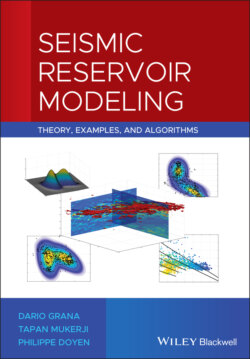Читать книгу Seismic Reservoir Modeling - Dario Grana - Страница 25
1.4.5 Gaussian Mixture Distribution
ОглавлениеGaussian and log‐Gaussian distributions are unimodal parametric distributions. However, many rock properties in the subsurface, for example porosity and permeability, are multimodal. Multimodal distributions can be described by non‐parametric distributions, but these distributions require a large amount of data to be estimated. In many applications, multimodal distributions can be approximated by Gaussian mixture distributions, i.e. linear combinations of Gaussian distributions.
We say that a random variable X is distributed according to a Gaussian mixture distribution of n components, if the PDF fX(x) can be written as:
(1.40)
where the distributions represent the Gaussian components with mean μX∣k and variance , and the coefficients πk are the weights of the linear combination with the condition . The condition on the sum of the weights guarantees that fX(x) is a valid PDF.
Figure 1.10 shows an example of Gaussian mixture PDF with two components with weights equal to 0.4 and 0.6, means equal to −2 and 2, and equal variance of 1. The resulting PDF is multimodal owing to the presence of two components with different mean values and asymmetric due to the larger weight of the second component.
An example of bivariate Gaussian mixture distribution with two components is shown in Figure 1.11. The PDF in Figure 1.11 is estimated from a geophysical dataset of porosity and P‐wave velocity. The two components represent two different rock types, namely high‐porosity sand and impermeable shale. The mean of porosity in the sand component is 0.22, whereas the mean of porosity in shale is 0.06. Porosity and P‐wave velocity are negatively correlated in both components; however, the Gaussian mixture distribution shows a larger variance within the sand component, probably because of the rock heterogeneity and the fluid effect. The distribution is truncated for porosity less than 0, to avoid non‐physical values.
Figure 1.10 Univariate Gaussian mixture probability density function, with two components with weights equal to 0.4 and 0.6, means equal to −2 and 2, and equal variance of 1.
Figure 1.11 Bivariate Gaussian mixture probability density function estimated from a geophysical dataset, in the porosity–velocity domain.
